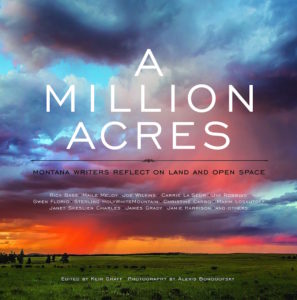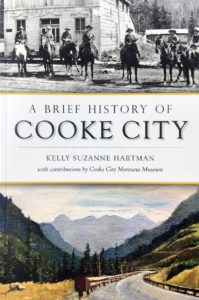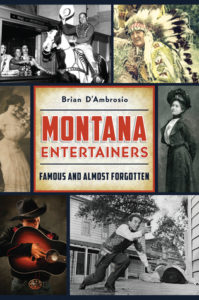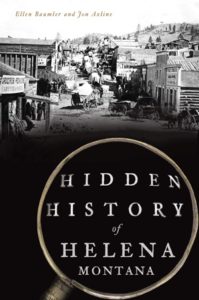For our spring reading list, Montana writers pay homage to Montana’s open spaces and the inner workings of nature, explore the animal origins of apparel, delve into the histories of Cooke City, Helena, the state’s Carnegie libraries, and both famous and forgotten entertainers.
Putting on the Dog, The Animal Origins of What We Wear

What’s in a wool sweater, a silk scarf, a pair of lambskin slippers? We slip into warmth unwittingly, especially during a cold Montana winter.
In her new book, Melissa Kwasny takes a more thoughtful and somewhat scientific look at human garb, revealing the history behind the hide, fur and feathers that keep us clothed. She leads readers on a journey that begins with a trip to Native village in Alaska, where she finds seal-gut parkas, thigh-high fish-skin boots, a coat of Arctic squirrel.
Closer to her home in East Helena, she visits High Plains Sheepskins to learn how wool slippers are made, watches a butcher flay a steer and sheep loose their fleeces, which are in turn spun to fiber. In Japan, she unravels the mesmerizing history of silk – that delicate metamorphose from silkworm egg to cocoons that each yield up to a half-mile of impossibly thin filament.
At Crow Fair in Montana, eagle feathers “bob, cross and criss-cross wildly as the dancers step.” Kwasny explores a pearl farm on the Sea of Cortez and a mink farm off the coast of Denmark. Each encounter fuels her curiosity about our relationships with the animals that sustain us.
Reciprocity, she concludes, is the appropriate attitude toward the natural world that gives us so much. “Buy clothes. Not very many. Made mostly from animals and plants. Then cherish and care for them.”
Kwasny, who is one of Montana’s two current Poets Laureate, pursues her quarry across the pages with an anthropologist’s eye, and a wordsmith’s heart.
– Kristi Niemeyer
A Million Acres: Montana Writers Reflect on Land and Open Space

Montanan writers pay homage to landscapes they love in A Million Acres: Montana Writers Reflect on Land and Open Space. This stunning book, edited by Keir Graff, features 20 powerful pieces of writing about Montana’s land and open spaces by the state’s finest contemporary writers. Contributors from across the state include Rick Bass, Maile Meloy, Christine Carbo, Carrie Le Seur, Gwen Florio, Jamie Harrison, Allen Morris Jones and Russell Rowland.
A Million Acres also includes 28 spectacular color landscape photographs by Alexis Bonogofsky.
The Montana Land Reliance sponsored the publication in celebration of its protection of one million acres of Montana’s agricultural land, fish and wildlife habitat, and open spaces.
In essays, memoirs, and short stories, the book’s 20 writers explore the plains, rivers, and mountains of Big Sky Country. They show how natural beauty and hardship are two sides of the same coin, and how sometimes the only way to cure heartache is to visit the great outdoors.
From a hardscrabble upbringing to the pain of losing the family land, from death on a river to the awe of landing a big fish, from backcountry encounters with grizzly bears to an out-of-stater’s happiness at making Montana her home, A Million Acres offers a wonderfully diverse range of experiences and perspectives.
The Eight Master Lessons of Nature

Montana author and ecologist Gary Ferguson offers new insights into the inner workings of nature’s wonders in this fascinating exploration into how many of the most remarkable aspects of nature are hardwired into people’s very DNA. What emerges is a dazzling web of connections that holds powerful clues about how to better navigate daily life.
Looking around at the world today – a world of social media, skyscrapers, super highways, melting ice caps and rampant deforestation – it is easy to feel that humanity has actively severed its ties with nature.
Through cutting-edge data and research, drawing on science, psychology, history and philosophy, The Eight Master Lessons of Nature offers a path forward. Ferguson balances science and spirit as he explores mystery, loss, the fine art of rising again, how animals make us smarter, and how the planet’s elders can help us lead more nourishing and sustainable lives.
“Ferguson’s eight assertions each speak to the powerful connections he sees between the natural and human worlds, each beginning with his lushly delivered observations of nature.” (Publishers Weekly)
Ferguson has written for a variety of national publications, including Vanity Fair, Orion, The Chicago Tribune and the Los Angeles Times, and is the author of 25 books on nature and science.
A Brief History of Cooke City

With claims staked, 1870s prospectors at Cooke City patiently waited for adequate transportation to get their ore to market. Eager enough, they named the town in honor of Northern Pacific tycoon Jay Cooke and his son Jay Cooke Jr. Ironically, Cooke’s influence in creating Yellowstone National Park stunted the growth of the town, as the park blocked any efforts to support a railroad through its borders.
Historian Kelly Hartman recounts the saga that left hundreds battling for a railroad that never came in A Brief History of Cooke City. For more than 60 years, the community’s residents waited for rail until a new economy took hold – tourism.
The dreams of the miners still live on in tumble-down shacks and rusty old mining equipment. And the successful vision of entrepreneurs offering rustic relaxation at the doorstep of Yellowstone continues to lure visitors.
Hartman was raised in Silver Gate, Montana, attending kindergarten through eighth grade at the one-room schoolhouse in Cooke City. She received earned her BFA in painting from Western Oregon University and was director of the Cooke City Montana Museum (which contributed to the book) from 2013-’16 – a time that included its grand opening. In the summer of 2016, she began work as the curator of the Gallatin History Museum in Bozeman, but still visits her home valley often and spends as much time as she can painting in the Beartooths.
Montana: Mountains & More

Photographer Rosella Mosteller shares 75 black and white images in her new book, inspired by Montana. “There is so much of Montana that doesn’t meet the eye until you take the time to put wear on the tread of your soles,” she writes. “The medium of black and white photography transforms the color of the landscape. What remains are images that give a person the emotive quality of Montana at its core.”
With camera in hand, she explores cold mountain lakes, meandering rivers, hot springs, and shifting light as it touches the trees and flowers, stone and grit of Montana’s natural world. Stories, facts, lists and haiku poems by the author augment her striking, desaturated images.
Mosteller attended the School of the Art Institute Chicago and earned a bachelor of fine arts decree from the Academy of Art University, San Francisco. Her work has appeared in numerous juried exhibitions across the state.
“Rosella Mosteller’s black and white images of the natural world are stunning in their composition and elegance,” writes Rita Fitzsimmons of Designworks. “With her technical ability and sharp attention to detail, she captures singular moments in time – images that have the power to enrich anyone who views her work.”
Her book is available at mostellerphotos.com.
The Best Gift: Montana’s Carnegie Libraries

Between 1910 and 1922, 17 Montana communities built libraries with money given to them by the era’s richest man, Andrew Carnegie. Fifteen of those libraries still stand today, and their story is compellingly told in this new book by Kate Hampton, the Montana Historical Society’s community preservation coordinator, and sponsored by the Montana History Foundation.
“Andrew Carnegie was no saint,” notes Hampton. “His philanthropic legacy, however, continues to be beneficial to educational and cultural institutions around the world – and in Montana.”
Just as he did in Hand Raised: The Barns of Montana, photographer Tom Ferris provides stunning detail of both the classic and unusual architectural elements of these iconic buildings. Hand-drawn architectural renderings and other historical images combine to create a detailed portrait of Carnegie’s rich legacy in Montana.
While some of the remaining 15 library buildings have been repurposed as office space, community centers and a museum, all of them still stand as cultural and architectural anchors of their communities.
Proceeds from the book, which is available from Farcountry Press, benefit Montana historic preservation. An exhibit is currently traveling the state, visiting many of the original 17 communities where Carnegie libraries were built.
Montana Entertainers: Famous and Almost Forgotten

For more than a century, Montana has supplied a rich vein of entertainment and personality to the nation – from daredevils to dancers, from actors to mimes.
Treasure State stars Gary Cooper and Myrna Loy found unparalleled success during the Golden Age of Hollywood. Born in Miles City in 1895, comedian Gilbert “Pee Wee” Holmes played sidekick to such stars as Tom Mix. One-time Butte resident Julian Eltinge went on to become America’s first famous female impersonator.
There was Taylor Gordon, whose golden voice propelled the son of a slave from White Sulphur Springs to Harlem Renaissance fame. From the little-known Robyn Adair to the ever-popular Michelle Williams, author Brian D’Ambrosio marks Big Sky Country’s long-standing connections with America’s performing arts world. The 210-page book, available from Arcadia Publishing, includes 77 black and white images.
D’Ambrosio is the author of more than 10 books, including Shot in Montana: A History of Big Sky Cinema, and his articles have been published in local, regional and national publications.
Hidden History of Helena, Montana

Two of Helena’s premier historians, Ellen Baumler and Jon Axline, have penned a new look at the Queen City’s past, available from Arcadia Publishing.
Distinguished by statesmen and magnates, Helena’s history is colored with many other compelling characters and episodes nearly lost to time. Before achieving eminence in Deadwood, Sheriff Seth Bullock oversaw Montana Territory’s first two legal hangings. The Seven Mile House was an oasis of vice for the parched, weary travelers entering the valley on the Benton Road, despite a tumultuous succession of ownership. The heritage of the Sieban Ranch and the saga of “King Kong” Clayton, “the Joe Louis of the Mat,” faded from public memory.
From unraveling the myths of Chinatown to detailing the lives of red-light businesswomen and the Canyon Ferry flying saucer hoax, Baumler and Axline team up to preserve a compendium of Helena’s yesteryear.
Baumler, who was interpretive historian at the Montana Historical Society from 1992 to 2019, is a longtime member of the Humanities Montana Speakers Bureau, a 2011 recipient of the Governor’s Award for the Humanities and an award-winning author. Axline, the historian at the Montana Department of Transportation for three decades, has written five books on Montana history.
Voices of Yellowstone’s Capstone: A Narrative Atlas of the Absaroka-Beartooth Wilderness
This unique collaboration between writers, artists and cartographers travels both the physical and intellectual terrain of the Absaroka-Beartooth Wilderness. Although the atlas – true to its name – contains maps, it is not a guidebook.
“Instead, in the way wilderness users explore physical trails on the landscape, readers are invited to explore the intellectual trails … [coming] away understanding not only the importance of designated wilderness and public lands, but the interconnectedness of humans and wild places over time.”
Voices of Yellowstone’s Capstone is made up of 28 engaging essays paired with richly illustrated maps by artists and map-makers, including Courtney Blazon, Travis Burdick, Monte Dolack and others. The long list of writers includes Dan Aadland, Susan Austin, Doug Chabot, John Clayton, Seabring Davis, Shane Doyle, and Gary Ferguson, Peter Halstead, Ed Kemmick, Scott McMillion, and Bernard Quetchenbach.
Editors Traute Parrie and Jesse Logan are both long-time veterans of the Forest Service.
The books is published by the The Absaroka-Beartooth Wilderness Foundation, a nonprofit group devoted to supporting stewardship of the Absaroka-Beartooth Wilderness through “boots-on-the-ground” experiences. Learn more at abatlas.org.